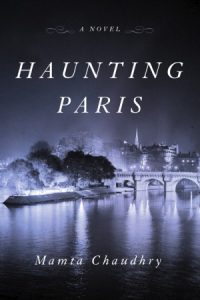The Story Behind the Book
Seeing Double in Paris: City of Shadows, City of Light
Do I believe in ghosts?
No, of course not. And yet . . . in Paris you can’t help but keep them company. They crowd the quays at night, dispersing for a moment as the blinding lights of the bateaux-mouches rake the shadows, but when the din of the tourist boats fades into the distance, the air is again thick with their presence.
The first time I saw Paris, I felt a shock of recognition, the way you do when you meet someone new and think, I know you, I’ve always known you.
But why should it seem so familiar when it’s different in every way from the tropical Indian city of my childhood, and from the American subtropics, which I now call home? I can’t explain that sense of déjà vu.
My husband said, maybe in another life, and we laughed because he’s married into a culture where talk of past lives is more common than remarks about the weather. In a daze of excitement, we explore Paris together, delighting in its grand splendors, its intimate charms. I long to know the “real” city rather than this shimmering mirage, but crossing the threshold, c’est difficile, I’m told, and for me it seems more than difficult, it seems impossible. I will always be an étrangère: a stranger, a foreigner, an outsider.
Lingering on the cobblestone quays, staring into lighted windows of the Île Saint Louis, I cannot shake off the feeling that phantoms haunt this place, their yearning almost palpable. What draws them back, I want to ask, but they retreat from the pools of lamplight into the shadows and into silence.
We cross the footbridge to the neighboring island in the Seine and before us Notre Dame with its soaring towers gestures towards the sky; but behind the cathedral, an ancient willow bends towards the water. Close by, in a sunken memorial, iron and stone speak of the horrors of those forcibly deported during the dark days of occupation, and at our feet a bronze circle is chiseled with the words: They went to the other end of the earth and they did not return.
The end of the earth, the final threshold from which the absent never return. Or do they? And then the hair slowly rises along my arms as I recall the French word for ghost: revenant, one who returns.
On our last evening in Paris, we stroll along the rue de Bièvre, and I notice a man a few feet ahead. Nothing remarkable about him, he’s wearing a suit and carrying a briefcase like hundreds of office workers rushing home after work. But unlike them, he’s not in a hurry. He stops suddenly in the middle of the street, places his briefcase on the ground, and launches into a Puccini aria. His voice swells over the noises on the street, the chattering at the outdoor tables subsides until there is pin-drop silence. For the two minutes or so it takes him to sing Recondita Armonia, it seems even the birds are holding their breath. He comes to the end of the aria––Tosca, it’s you!—then matter-of-factly tucks his briefcase back under his arm, and goes on his way without so much as a bow or wave to acknowledge the applause.
An ephemeral scene, yet I’m certain I will remember it until both memory and breath are quenched. And this piercing intimation of mortality stops me in my tracks. Strange to feel it now, when we are young, in love, and the future stretches before us full of infinite promise, but right there on the pont Saint-Louis I am at once the island that I love, the bridge that links it to the world, and the dark river that flows beneath, separate yet connected, so alive and so aware of death.
“I can’t believe we’re leaving already,” I tell my husband.
“Paris will still be here.”
“I don’t mean just Paris. This moment, this life.”
He draws me close, and with our arms around each other we walk back to our hotel to pack for home.
That was many years ago, the first time I saw Paris.
We stand in the same spot now, the promise of our early days tempered by the passage of years and the gathering of sorrows, but thankful for present love and present laughter, when I see our younger selves crossing towards us on that bridge, into their future, which is already our past.
It’s true that Paris is still here. But now I am, if not exactly on the inside, at least no longer an outsider. One day as I admire a spectacular view of the Eiffel Tower through the windows of Palais Chaillot, I slowly become aware of a stained-glass panel from Chartres on the wall behind reflected in the same panes: an uncanny palimpsest of past and present. And then a face appears in the glass, taking me aback until I realize it’s my own face, familiar and yet unfamiliar. That’s what it must feel like, I think, to be a ghost.
And all of a sudden, I have a dizzying sense of being not just in the present moment, but seeing through deep time a dazzling enfilade of doorways opening into other lives, other stories. I think of the plaster cast of the Inconnue of the Seine, a nameless drowned girl dragged from the river whose pale, smiling face inspired countless poems, books, films. Yet no story can pin her down, she remains forever elusive, forever enigmatic. Like the recondita armonia of the aria heard so long ago on the streets of Paris, some harmonies remain mysterious. As do people and places we love. No matter what stories we tell, mingling memory and desire, they remain a mystery.
Only its ghosts know Paris.

